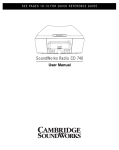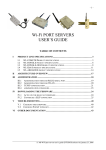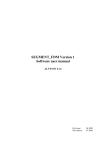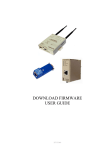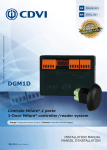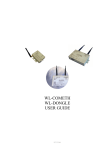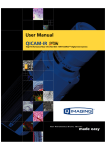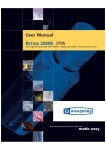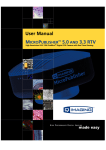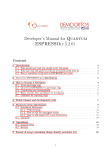Download Electrolux Oven User's Manual
Transcript
ENGLISH IMPORTANT! This new appliance is easy to use. Nonetheless, to obtain best results it is important to read this brochure carefully and to follow all the instructions before using for the first time. In additon to instructions for installation, use and maintenance of the appliance, you will find other useful advice in this brochure. GUARANTEE Your new appliance is under guarantee. You will find the guarantee certificate attached. If it is missing, request it from your retailer indicating the date of purchase, model and identificaton number which are engraved on the appliance’s small registration plate. Retain the certificate in order to present it to the Technical Assistance Service with the receipt or invoice in case of necessity. The Zanussi Technical Assistance Service, through its numerous authorized Centres, provides assistance to the most important makes of electrical domestic appliances. In case of necessity contact the nearest Centre by consulting the telephone directory under the name ZANUSSI or, of course, the yellow pages under the section Electrical Domestic Appliances/ Repairs. This appliance conforms to the following EEC Directives: . 72/23 - 90/683 (Low Tension); . 89/336 (Electromagnetic Compatibility); . 93/68 (General Directives); and successive modifications. Voltage tension: 230V / 400V 3N - 50Hz Electrical power: 7.750 kW max/ZC 607E - 7.715 kW max/ZC 603E MANUFACTURER: ELECTROLUX ZANUSSI ELETTRODOMESTICI S.p.A. Viale Bologna, 298 47100 FORLI’ (Italy) Once your appliance has been installed by a qualified installer according to the recommendations contained in the second part of this brochure, we request you to read the following pages in order to get the best use from your cooking appliance. These instructions are only valid for countries whose identification symbols are shown on the inside cover of this information brochure and on the appliance itself. 60 INSTRUCTIONS - ELECTRIC OVENS This brochure must be kept together with the appliance for consultation at any time. If the appliance is sold or transferred to another person, ascertain that the brochure is also given, in order that the new user can be aware of the correct use of the machine and the relative warnings. THESE WARNINGS HAVE BEEN PREPARED FOR YOUR USE AND SAFETY AND FOR THAT OF OTHERS, WE THEREFORE REQUEST YOU TO READ THEM CAREFULLY BEFORE INSTALLING AND USING THE APPLIANCE. • This appliance has been designed for use by adults. • The accessories (grill and dripping pan), must be Take care, therefore, of children who could attempt to play with it. washed before using for the first time. • The work of instalation must be carried out by form not to direct the spray onto the thermostat bulb. competent and qualified installers according to the regulations in force. • If, when placing food in the oven, or when removing • Take care when using cleaning products in spray may be necessary for the installation of the appliance should only be carried out by competent personnel. it, a large quantity of oil, cooking juice, etc. spills onto the bottom of the oven, take care to clean before starting to cook to avoid unpleasant smoke and the possibility of its catching fire. • For all repairs contact an authorized Technical • Ensure that air can circulate around the appliance. Assistance Service and insist on original spareparts. Poor ventilation produces a lack of oxygen. In case of doubt ask the installer for advice. • Any modifications to the domestic installation which • It is dangerous to modify, or attempt to modify, the characteristics of this appliance. • For reasons of hygiene and safety this appliance • Do not place unstable or deformed pans on the must always be kept clean. A build up of grease or other food can cause fires. plates to avoid their upsetting or their contents boiling over. • This product is intended for the preparation of food • Particular care should be taken when cooking with and must not be used for other purposes. oil or fat. • Avoid installation of the cooker near inflammable • The appliance remains hot for a long time after being switched off. Supervise children when in use, paying atention that they do not touch surfaces or remain too close to the appliance when in use or before it is completely cooled. • Always insert the dripping pan when using the grill or when cooking meat on the grill. Add a little water to the dripping pan to avoid fats creating unpleasant smells during the first few minutes of operation. material (e.g. curtains, tea towels, etc.). • Do not cover the sides, and particularly the base, of the oven with aluminium foil. • The appliance is heavy, take care when moving. • Before carrying out maintenance or cleaning, disconnect the appliance and allow to cool. • Ensure that the oven grills are correctly inserted (see instructions). • Always use oven gloves to remove and replace • Only heat-resistent dishes should be placed in the food in the oven. drawer situated under the oven. Do not place inflammable items in it. • When using for the first time we advise you to switch on the oven and allow it to heat whilst empty for approximately 15 minutes at maximum temperature. Then allow to cool before cleaning the inside of the oven with water and a non-abrasive cleaning product. • If the appliance requires repair, this should be carried out by qualified personnel as you could cause damage. Contact the nearest Assistance Centre and only use original spareparts. 61 TABLE OF CONTENTS Instructions for the user Installation Electric oven Advice for oven use Grilling Cooking table Maintenance Instructions for installer Electrical connection What to do if ... Technical assistance and spareparts When cooking in the oven or the grill, the appliance is subject to considerable heat, particularly around the door and nearby area. Take care, therefore, that children do not attempt to approach when playing. If electrical appliances are plugged in near the oven, take care that the lead does not touch the cooking areas and does not become trapped in the oven door. OVEN DOOR PROTECTION SHIELD Our appliances conform to the EUROPEAN SECURITY REGULATIONS. To offer better protection to children who could be burnt by the oven door when in use, a shield can be applied to the door itself. This shield can be purchased in our after-sales service shops. The fitting instructions are supplied with the kit. 62 Page 63 Page 63 Page 65-68 Page 71 Page 72 Page 73 Page 74 Page 76 Page 77 Page 78 Page 78 APPLIANCE DIMENSIONS Height Width Depth 850 mm 600 mm 600 mm H W D The total power absorbed and supplementary technical data are shown on the small registration plate placed on the bottom of the oven (for access, open the oven door). INSTRUCTIONS FOR USER INSTALLATION It is important that all operations relating to instalation and regulation be carried out by qualified personnel, according to the rules and regulations in force. Specific instructions are described in the chapter intended for the installer. BEFORE using the appliance take care to remove the special film which protects parts in inox or stainless steel. 63 PRACTICAL ADVICE COOKING RECIPIENTS Remember that a large recipient offers a larger surface to heat and therefore cooks food quicker than a narrow recipient. Always use recipients of a size suitable for the food to be cooked. In particular, take care that recipients are not too small for liquid preparations which could easily spill over or that they are not too big for food which must be cooked quickly; uncovered areas on the bottom are easily burnt by fats and juice. For cakes, it is preferable to use tins which do not open. A tin which opens lets out fruit juices and sugar which, when spilling onto the bottom of the oven, caramelize and are difficult to clean. Avoid placing pans with plastic handles in the oven as they may not support the heat. ELECTRIC PLATES Sealed hotplates The control panel incorporates knobs to operate the four hot plates. There are two different types of plates. Normal This is a 7 position control knob: 0 = off and 1-6 indicate the levels of power uo to the mawimum. Rapid hot Plate This type is indicated by a red circle in the middle of the plate. The red circle is painted on and so will deteriorate and may come off completely over a period of time. A rapid plate will heat up much more quickly than a normal plate, and the knob is the one in Fig. 1. Saucepans suitable for use on solid plate hobs should have several characteristics: - they should be heavy duty. - they should fit the heat area exactly, or be slightly larger for efficient use, NEVER smaller. - they should have a flat base to ensure good contact with the plate (Fig. 2). This is particularly important when using pans for high temperature frying or pressure cooking. Ensure pans are large enough to avoid liquids being split onto the plates. Never leave the plates on without a pan on them or with an empty pan on them. 0 3 YES 1 2 NO FO 1134 64 Fig. 1 NO Fig. 2 TRADITIONAL ELECTRIC OVEN Control switch (Fig. 3) Permits the choice of cooking temperature most suitable and separate action of the heating elements. Explanation of symbols: 0 Oven switched off Oven lamp 50-max Range of temperature regulation lower heating element upper heating element grill element To select the temperature turn the switch in a clockwise direction and place sign in front of the symbol corresponding to the temperature required, included between 50˚C and max. The temperature will be maintained constant by the thermostat. If a different type of heating is required, for example more heat on the bottom or the top, you should turn the switch to the symbols (heat from below) or (heat from above). In these conditions the temperature will never exceed 220˚C for and 180˚C fo r and will not be regulated by the thermostat. FO 0762 Fig. 3 FO 0152 Fig. 4 FO 0375 Fig. 5 When grilling, it is sufficient to turn the switch so that the sign is in front of the symbol When the grill is in use the oven door must be left ajar and the switch protection shield inserted (Fig. 4 and 5). When cooking in the oven or grill, in order to avoid over-heating, always leave the appliance’s cover open. The oven is supplied with an enamelled dripping pan for the collection of cooking juices from grilled meat or kebabs, and a grill for cooking grilled food, which can also be placed in a dish. In models equipped with an oven grill with stopper (fig. 5) and when grilling, to avoid dirtying the oven excessively, we advise you to insert the drippng pan (A-fig. 6) in the specific grids, situated under the grill (B-fig.6). If you need to cook with the dripping pan on the oven grill, place as shown in Fig. 6. 65 Pilot lamp When lit indicates the operation of one or more heating elements. Oven thermostat pilot lamp Switches off when the oven reaches the selected temperatue and re-lights each time the thermostat intervenes to maintain the temperature. FO 0190 Fig. 6 Mechanical timer The timer can be regulated for a maximum of one hour. The control switch (Fig. 7) must be turned in a clockwise direction to the 60 minutes postion then in an anti-clockwise direction to the time required. Once the pre-established time has elapsed, an acoustic signal intervenes which stops automatically. The action of the time cannot stop the oven. FO 0763 66 Fig. 7 ELECTRIC OVEN (5 FUNCTIONS) Selector switch for type of cooking (Fig. 8) and thermostat regulation (Fig. 9) These two switches allow you to choose the type of cooking (choice of heating element) as well as the temperature according to the requirements of the recipe. The oven lamp stays lit in all positions. Meaning of symbols Upper and lower heating Grill Lower element Upper and lower elements plus fanned air De-freezing Traditional cooking Turn the selector switch to bring the sign to position and regulate the thermostat to the required temperature. Grilling Turn the selector switch to bring the sign to position and regulate the thermostat to the required temperature. Upper heating only Turn the selector switch to bring the sign to position and regulate the thermostat to the required temperature. Fanned air (convection) Turn the selector switch to bring the sign to position and regulate the thermostat to the required temperature. De-freezing Turn the selector switch to bring the sign to position . In this mode, the electric fan circulates cold air inside the oven, activating de-freezing of food. When the selector switch (Fig. 8) is in position , regulate the thermostat (Fig. 9) to position . For 5 function ovens of the model shown below, when the grill is in use the door should be left ajar and the control switch protection shield inserted (Figs. 10 and 11). FO 1135 Fig. 8 FO 0152 Fig. 10 FO 1114 Fig. 9 FO 0375 Fig. 11 67 Oven thermostat pilot lamp Goes out when the oven reaches the selected temperature and comes back on when the thermostat intervenes to maintain the temperature. When cooking in the oven or grill, in order to avoid over-heating, always leave the appliance’s cover in place. The oven is equipped with an enamelled dripping pan for the collection of cooking juices from grilled meat or kebabs, and a grill for cooking grilled food, which can also be placed in a dish. In models equipped with an oven grill with stopper (Fig. 11) and when grilling, to avoid dirtying the oven excessively, we advise you to insert the dripping pan (A-Fig. 12) in the specific grids, situated under the grill (B-Fig. 12). If you need to cook with the dripping pan on the oven grill, place as shown in Fig. 12 68 FO 0190 Fig.. 12 ELECTRONIC MINUTE MINDER 1. ( - ) DECREASE CONTROL AND MINUTE MINDER SETTING BUTTON. 2. ( + ) INCREASE CONTROL. + - ( ) COOKING SYMBOL. ( ) CLOCK SETTING CONTROL. ( ) SET TIME STOP PUSH BOTH Fig. 13 MINUTE MINDER SYMBOL. The electronic minute minder can indicate the time of day, operate as a minute and it can be used to time and switch off the oven. + 1. SET THE TIME OF DAY SET TIME STOP PUSH BOTH Fig. 13.1 When the electricity supply is first switched ON, the display will flash both 88:88 and ( ). See Fig. 13.1. Press buttons (1) and (2) together. The display will read 12:00. See Fig. 13.2. Within 5 seconds, press and hold either button (1) to decrease or button (2) to increase the time until the correct time of day on the 24 hour clock is reached, e.g. 14:30. The cooking symbol ( 13.3. + SET TIME STOP PUSH BOTH Fig. 13.2 ) will go out. See Fig. Note: The increase and decrease control buttons operate slowly at first and then more rapidly. They should be pressed separately. + 2. THE MINUTE MINDER SET TIME STOP PUSH BOTH Fig. 13.3 IMPORTANT The minute minder can be used to time a set cooking period. At the end of the cook time the minute minder will automatically switch off the oven if in use. The minute minder gives an audible reminder at the end of any period of cooking up to 23 hours and 59 minutes. + SET TIME STOP PUSH BOTH To set, press button (1) and the display will read 0:00. See Fig. 13.4. Release button (1) and press and hold button (2). The display will count up in one minute intervals until the interval to be timed is reached e.g. 30 minutes, see Fig. 13.5. If necessary, press and hold button (1) to achieve + STOP SET TIME Fig. 13.4 PUSH BOTH Fig. 13.5 69 the correct time interval. The minute minder will begin to count down once set. At the end of the timed period, the minute minder will click, switching the oven OFF in use. An audible signal will sound for up to 30 seconds. The display will flash showing the time of day. See Fig. 13.6. + SET TIME STOP PUSH BOTH Fig. 13.6 To stop the sound and flashing, press button (1). The display will stop flashing and show the time of day, e.g. 15:00. The cooking symbol ( ) will go out. See Fig. 13.7. If using the oven it will come on again once button (1) has been depressed. When cooking is complete remove food and turn OFF oven temperature control. + SET TIME STOP PUSH BOTH 3. TO CANCEL THE MINUTE MINDER Fig. 13.7 Press and hold button (1) and the display will count down in one minute intervals to 0:00. See Fig. 13.8. Release button (1). If the oven is in use this will switch OFF after a few seconds. To reset the time of day, press button (1) and (2) together. See Fig. 13.9. + SET TIME STOP PUSH BOTH Fig. 13.8 4. THINGS TO NOTE 1. If at first you do not set the time of day correctly,reset the clock by pressing and holding button (1). The display will count back to 00:00. Release the button. After a few seconds, the display will reset to show 12:00. To reset the time of day, follow the procedure laid down in point 1 on page 69. 2. The time of day must be set before the oven will operate. There will be a few seconds dealy before the oven switches on. 3. The minute minder function controls the main oven only and will switch the oven OFF at the end of a timed period. This funciton is useful if you want to begin cooking now and have the oven switch OFF automatically. 4. If you have used the minute minder to time food cooking in the oven you will need to reset the timer by pushing both buttons before the oven can operate again. 70 + STOP SET TIME PUSH BOTH Fig. 13.9 SOME ADVICE FOR THE USE OF YOUR OVEN Traditional cooking Heat originates from top and bottom, dishes should preferably be placed in the middle. If cooking requires more heat from the bottom or the top, use the upper or lower level. Convection cooking Heat is transmitted to dishes by hot air forcibly circulated inside the oven by a fan placed at the back of the oven. By this method, heat is quickly and evenly circulated throughout the oven, permitting several different dishes to be cooked at the same time on different levels. With this cooking method, through the elimination of humidity in the air and a drier environment, smells and tastes are not given off and do not mix with those of other dishes. Thanks to this possibility of cooking on several levels, you can cook up to three different dishes at the same time, to be consumed immediately or frozen. You can also cook on only one level. In this case, it is advisable to place the dish on the lower level for better cooking control. This oven is particularly suitable for de-freezing rapidly, sterilizing preserves, homemade jams and, finally, for drying mushrooms and fruit. Cooking in the multi-function oven This type of oven permits different types of cooking: traditional, convection, fanned heat and grilling; cooking can therefore be optimized. 71 ADVICE FOR THE USE OF YOUR TRADITIONAL OVEN For the preparation of cakes Pre-heat the oven, unless indicated differently, for at least 10 minutes before use. do not open the oven door when cooking dishes which must raise (e.g. raised pastries and soufflés); the jet of cold air would block the raising process. To check if cakes are cooked, insert a toothpick into the mixture; if it comes out clean the cake is ready. Wait until at least 3/4 of the cooking time has passed before doing this check. As a general rule remember that: A dish which is well-cooked on the outside but not sufficiently cooked inside, would have required a longer cooking time but lower temperature. On the contrary, a “dry” texture would have required a shorter cooking time but higher temperature (Fig. 14). For the preparation of meat: Meat to the cooked in the oven should weigh at least 1 kilo to avoid its becoming too dry. If you want roasts with a good colour, use very little oil. If the piece is lean, use a little oil and butter. Butter or oil are unnecessary if the piece has a strip of fat on top. If the piece has a strip of fat on one side only, put it in the oven with this side upwards; when melting the fat will grease the lower side sufficiently. Red meat should be removed from the fridge one hour before cooking otherwise the sudden change of temperature could cause it to become tough. A roast, especially if of red meat, must not be salted at the beginning of cooking as salt causes juices and blood to seep out of the meat, thus preventing the formation o a well-browned crust. It is advisable to salt the outside the of the meat after just over half the cooking time. Place the roast in the oven in a dish having a low rim; a deep dish acts as a shield and prevents heat from circulating. Meat can be placed on an ovenproof dish or directly on the grill, under which the dripping pan should be inserted to collect juice. Ingredients for gravy should only be put in the dish immediately if cooking time is brief, otherwise they should be added during the last half hour. Begin cooking rare meat at a high temperature, reducing the temperature to finish cooking the inside. The cooking temperature for white meat can be moderate throughout. The degree of cooking can be checked by pressing the meat with a fork; if it does not give the meat is cooked. At the end of cooking it is advisable to wait at least 15 minutes before cutting the meat in order that the juices are not lost. Before serving plates can be kept warm in the oven regulated at minimum temperature. For the preparation of fish Cook small fish from start to finish at a high temperature. Cook medium-sized fish initially at a high temperature and then gradually lower the temperature. Cook large fish at a moderate temperature from start to finish. Check that baked fish is cooked by gently lifting one side of the gut; the meat must be white and opaque throughout, except in the case of salmon, trout or similar. In any case, carefully follow the instructions of the recipe you are using. Grilling The following types of meat are suitable for grilling. Meat or offal cut in slices or pieces of various sizes but not usually very thick, poultry cut in half and flattened, fish, some vegetables (e.g. courgettes, aubergines, tomatoes, etc.), skewers of meat or fish and seafood. Meat and fish to be grilled should be lightly brushed with oil and always placed on the grill; this should be positioned on the level nearest or furthest from the grill in order to control cooking to avoid burning the surface or leaving the inside uncooked. Pour 1 or 2 glasses of water into the dripping pan in order to avoid the formation of smoke caused by drops of juice and fat. The grill can also be used to brown, toast bread and grill certain types of fruit, such as bananas, halved grapefruit, slices of pineapple, apples, etc. Fruit should not be placed too near the source of heat. Cooking times Cooking times can vary according to the type of food, its consistency and its volume. It is advisable to watch when cooking for the first time and check results in order to prepare the same dishes in the same conditions and thus obtain constantly similar results. The “table of cooking times” relating to cooking in the oven and by grill is provided as a guide. Experience will show possible variations to the values set out in the table. FO 0061 72 Fig. 14 TABLE OF COOKING TIMES Type of food Temperature °C Level * Cooking time Electric oven Cakes in moulds with beaten egg white mixtures Marble cake Girdle cake Sponge cake 175 175 175 2 2 2 60-70 60-70 35-40 Shortpastry Flan base Cheesecake Jam tart 200 200 200 2 1 1 15-20 35-40 35-40 Cakes in moulds with raised mixtures Buns 200 2 35-40 Small cakes Shortpastry Eclairs Meringues 170 200 140 2 2 2 10-15 30-40 120 Lasagna 225 2 40-50 Meat (cooking time by thickness in cm.) Roasts, slow cooking Roasts, brief cooking Italian meatballs 175 200 200 2 2 2 12-15 10-12 30-40 Poultry Duck 1-1/2 - 2 kg Goose 3 kg Roast chicken Turkey 5 kg 200 200 200 175 2 2 2 2 120-180 150-210 60-90 240 Game Hare Leg of venison Leg of deer 200 200 175 2 2 2 60-90 90-150 90-180 Vegetables Gemüsetopf 200 2 40-45 Fish Mullet 200 2 40-50 Pizza 240 1 20-25 3 3 2 15-20 20-25 60-70 70-80 60-90 Grill Pork chops Sausages Grilled chicken Veal roasted on the spit 0.6 Kg Chicken on the spit *The level number is counted from the bottom (not including the rest on the base of the oven where the dripping pan can be inserted. 73 MAINTENANCE Cleaning of the cooker Splashes of juice, fruit juice, etc. must be removed as quickly as possible with a damp cloth as they could, in time, cause the enamel to loose its shine. To remove light scratches from the enamel, use slightly abrasive cleaning products in powder form. Do not use steel wool or knives to remove deposits of dirt. For daily cleaning use soap and water or one of the numerous products available commerically. Wash the enamelled grills with water and a cleaning product. Clean the oven door with hot water only, avoid using rough clothes or abrasive substances. Only clean the electric plates once they have become cold. Both the plates themselves and their edges can be cleaned with a fine emergy-cloth. They can be oiled occasionally with a little vegetable oil or vaseline whilst they are still hot. Cleaning of the oven Carefully clean the oven after use and whilst still slightly warm. In fact this is when deposits of fat or similar, fruit juices, particles of sugar or grease can be most easily removed as they will not have had time to become hard. Use hot water and a cleaning product or a product in spray form which can be obtained commercially. When using, follow with manufacturer’s instructions. Do not direct sprays onto parts in burnished steel, as you could damage them. Clean oven accessories (grill, dripping pan, etc.) with hot water and a cleaning product. Remove any deposits by means of a slightly abrasive powder. Never cover the sides or the bottom of the oven with aluminium foil to collect splashes of fat. The resultant accumulation of heat would affect cooking results and could damage the enamel. Replacement of the oven lamp (Fig. 15) Disconnect the appliance Unscrew the lamp and replace with another, capable of tolerating high temperatures (300˚C) having the following characteristics: Tension: 230 V (50 Hz) Power: 15W Cap: E14 FO 0424 Cleaning of the oven door To clean the oven door completely it is advisable to dismount it by following these instructions (Fig. 16): - open the door completely; - turn the two staples positioned on the hinges’ arm 180˚; - partially open the door to an angle of -30˚, lift the door and remove from the front. Replace the door by carrying out the operations described in reverse. FO 0967 74 Fig. 15 Fig. 16 Cleaning of the cover To clean the cover well, open and remove from it’s support as shown in Fig. 17 After cleaning, remount by pressing down heavily to replace it in its support. FO 0418 Fig. 17 CARE OF CATALYTIC SIDES The catalytic sides can neutralise most food and splashes of grease when the temperature exceeds 220˚C. To facilitate cleaning, it is advisable to heat the oven, empty, above this temperature for 1 to 2 hours a week. Practical advice: . . . . . Manual cleaning of catalytic sides is not advisable. These sides are irremediably damaged by the use of sprays, steel wool soaked in soap or other detergents. With time some discolouring of the sides may occur. This will not affect the catalytic action. Once the sides are saturated the cleaning process ceases. This does not effect the appliance’s operation. Follow the advice given below in order to reduce to a minimum the formation of splashes in the oven. How to diminish splashes? Some advice: Always cook at the recommended temperature. When roasting, temperatures which are too high can contribute to the formation of splashes. Try to cook at lower temperatures (do not, of course, forget to adapt cooking times). You will save energy and roasted meat will be much more tender. Use only a small quantity of fat or oil, or even no fat at all when roasting meat. The addition of fat when grilling or roasting contributes to the formation of splashes of fat. It is unnecessary to add water when roasting or grilling meat. The addition of water and the meat juices will contribute, during the cooking process, to the formation of fat splashes and condensation. The sides are better protected against splashes if the dish containing the roast is covered. In this case the covering must be removed 20-30 minutes before the end of cooking; meat will be roasted better on the outside. Some large pieces of meat and turkey can certainly be cooked in this way; the inside will thus be cooked before the outside burns. Always use the dripping pan when roasting or grilling meat. The long life of your catalytic sides is dependent on your following this fundamental advice. 75 INSTRUCTIONS FOR THE INSTALLER The following instructions are intended for the installer in order that the operations of installation, regulation and maintenance are carried out in the best possible manner and according to the regulations in force. All interventions must be carried out with the appliance disconnected. THE MANUFACTURER DECLINES ALL RESPONSIBILITY FOR DAMAGES CAUSED BY AN INSTALLATION WHICH DOES NOT CONFORM TO THE REGULATIONS IN FORCE. Installation and maintenance of the appliance must be carried out by a professional qualified according to the articles regulating the art in force, noteably: NBND 51003. For appliances connected to the electricity network: regulation NBN. We shall not be responsible in case of accidents or incidents caused by inexisting or defective earthing. PLACEMENT The appliance is of type X. It has been designed to be placed between two other units whose sides can tolerate temperatures exceeding that of the room by 75˚C. WHEN THE COOKER IS FIRST INSTALLED Once the cooker has been installed it is important to remove the protective materials which were put on in the factory. Switch the oven control to MAX and leave it to run, empty, for 30 minutes to remove any unpleasant new smells. Please ensure that when the appliance is installed it is easily accessible for the engineer in the event of a breakdown. LEVELLING The cookers are supplied with adjustable feet fitted on the back and front angles of the base. The feet can be regulated (Fig. 18) to adjust the height of the appliance to that of the neighbouring units and for an even distribution of liquids contained in pans. FO 0063 76 Fig. 18 ELECTRICAL CONNECTION Prior to making the electric al connection, make sure that: - The protection fuse and the domestic wire system are suitable to carry the total electric load of the oven (see rating plate). - - Your domestic wiring system has an efficient earth connection in compliance with the rules and laws in force. The wall socket or the omnipole switch used for the electrical connection can easily be reached after the oven is built in. The appliance is delivered without an electric supply cable, therefore, you will have to fit to it a supply cable with standard plug, suitable for the total electric load shown on the rating plate. The plug is to be inserted into a suitable wall socket. If you require a direct connection to the electric network (mains), it will be necessary to fit between the appliance and the mains an omnipole switch, aith a minimum gap between contacts of 3 mm. suitable for the required load and in compliance with rules in force. The green 1 yellow ground wire must not be interrupted by the switch. The supply cable must in all cases be laid out in such a way as to ensure that it does not reach at any given point a temperature 50°C higher than the ambient temperature. The manufacturer disclaims any liability in case these accident-preventing rules are not observed. Suitable power supply cables are the following types, considering the respective necessary section of cable. • • • • H07 RN-F H05 RN-F H05 RR-F H05 VV-F CONNECTING THE TERMINAL BOARD The appliance incorporates an easily accessible 6pole terminal board whose jumpers (bridges) are already pre-set for operation on 230 V single-phase (Fig. 19). In case where different mains voltage is present, the jumpers on the terminal board must be arranged as shown in the diagram (Fig. 20). The ground cable must be connected to terminal . After connecting the supply cable to the terminal board, secure it with a junction clamp. Fig. 19 FO 0330 230V 3~ 230V 1~ 400V 2N~ 400V 3N~ 1 2 3 4 5 L1 L2 L3 PE 1 2 3 4 5 L1 N 1 2 3 4 5 PE L1 L2 N 1 2 3 4 5 PE L1 L2 L3 N PE Section of cable (min.) 4 x 1.5 mm2 Section of cable (min.) 3 x 2.5 mm2 Section of cable (min.) 4 x 2.5 mm2 Section of cable (min.) 5 x 1.5 mm2 FO 0584-EN Fig. 20 77 WHAT TO DO IF THE APPLIANCE DOES NOT WORK If the appliance does not work correctly, before contacting the technical assistance, check the following points: Cooking time is too long: • check that the temperature chosen is suitable to the food to be cooked. If the appliance fails to operate: • check that the socket switch and/or the switch from the supply to the oven are ON. The oven produces smoke: • we advise you to clean the oven after each use; when cooking meat splashes of fat are formed, if they are not cleaned they can cause smoke and smells during successive cooking (see paragraph concerning cleaning). If the oven does not come on: • check that the programmer is properly set for manual operation, or that you have programmed any automatic cooking correctly. • check that it is properly plugged in. • check that the socket switch is turned on. • check that the socket is supplying power - do this by plugging in another appliance that is known to be working properly. • check that the fuse is the plug is intact. If the hob area does not work: • check that you are turning the correct control knob. The oven light does not work: • the lamp has certainly burnt; to replace follow the instructions provided in the paragraph on this subject. If, after all the controls indicated above, the appliance still does not work, contact your nearest technical assistance centre providing them with full details of your appliance: model and registration number. The oven does not heat: • check that the oven switch is in the working position. TECHNICAL ASSISTANCE ORIGINAL SPAREPARTS Before leaving our workshops, this appliance has been tested and adjusted by experts and specialized personnel in order to give you the best possible results. Any repairs or adjustments necessary thereafter should be made with great care and attention. For this reason, we recommend you should always contact the retailer who sold you the appliance or our nearest Assistance Centre specifying the type of fault and the model of your appliance. 78 Original spareparts, certified by the product manufacturer and carrying the following symbol are only available at our Technical Assistance Centre and authorized spareparts shops.





















